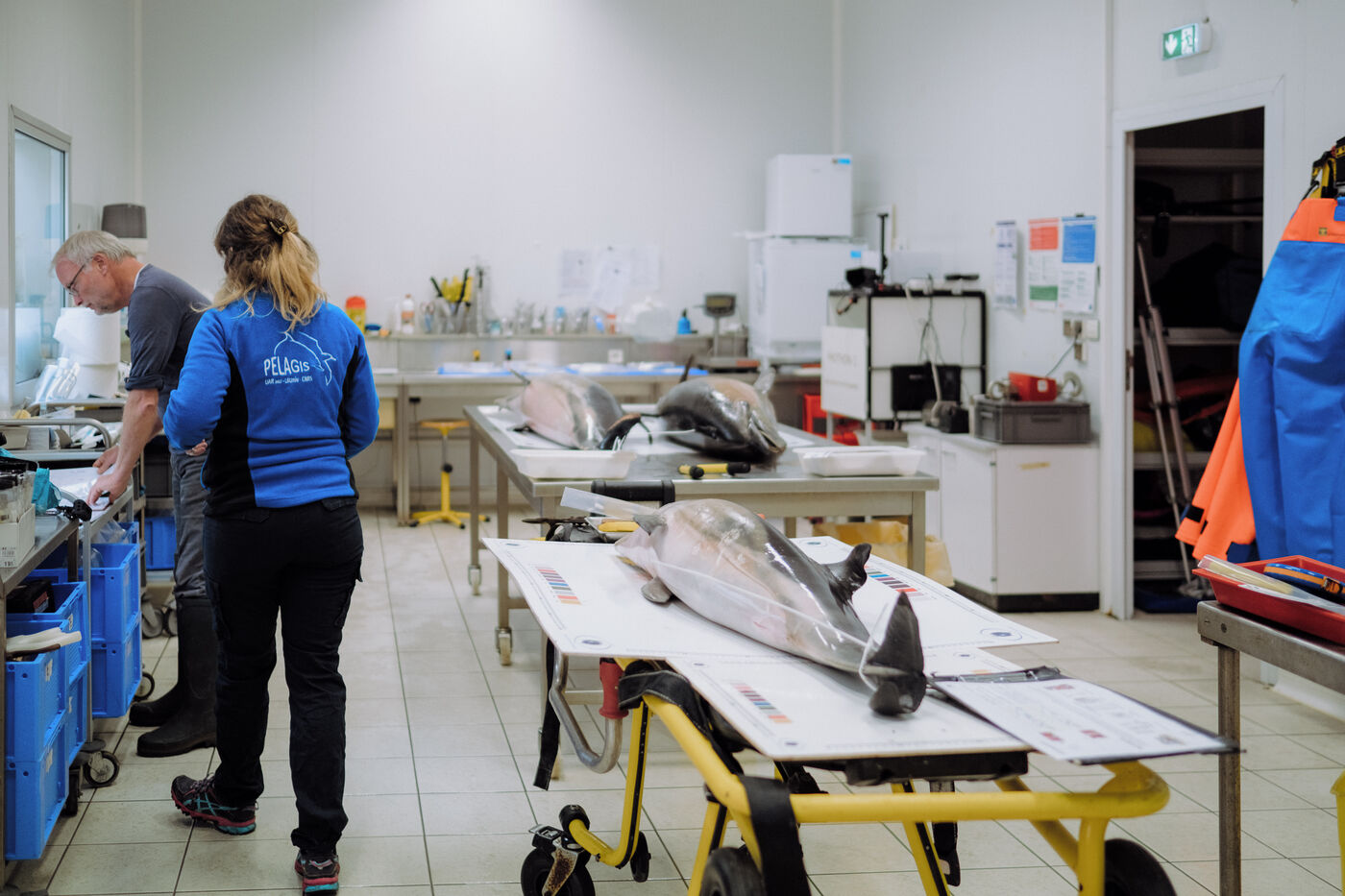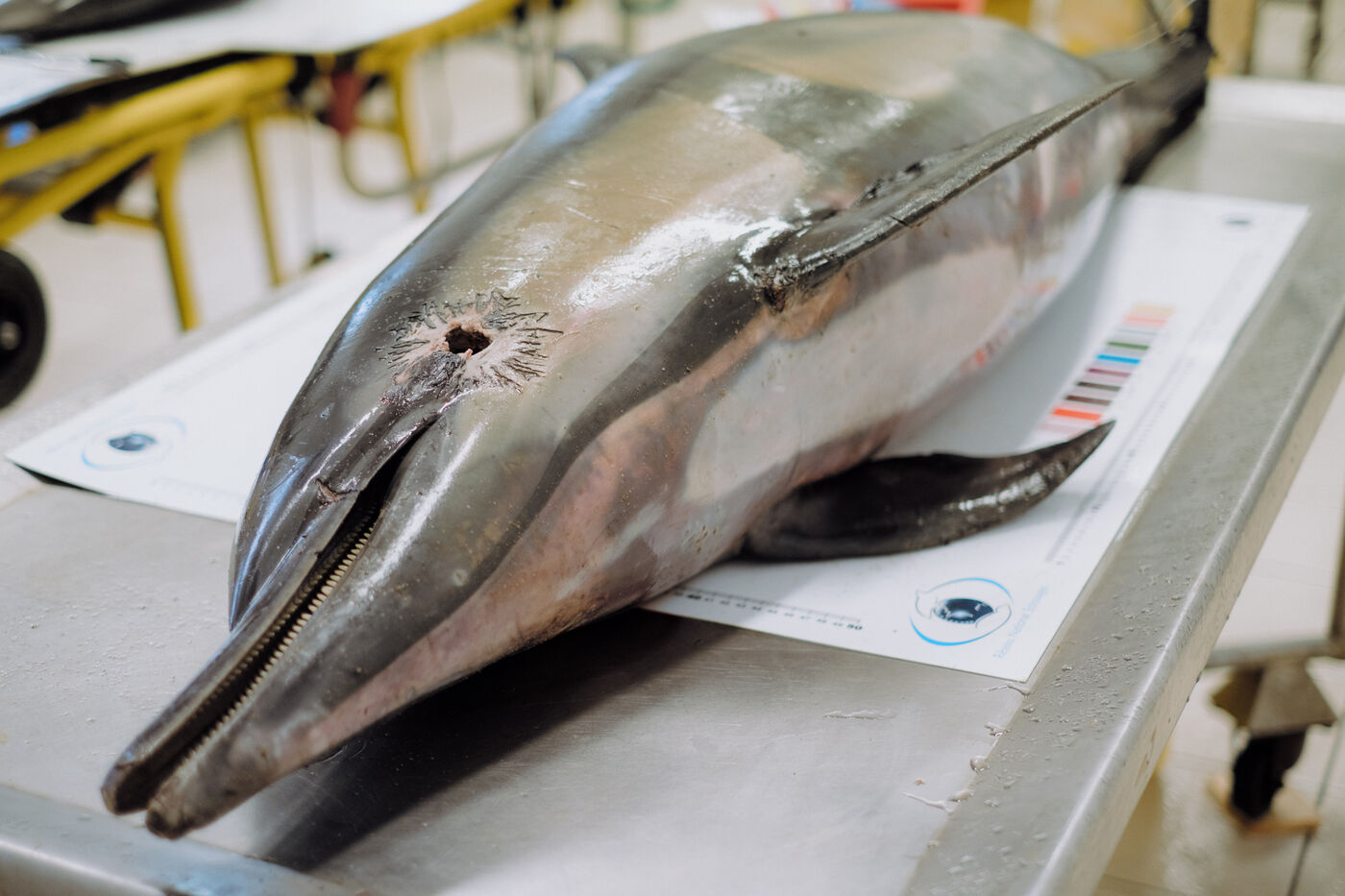Pour accéder à la série en entier, vous devez vous logger ou demander un compte Hans Lucas en cliquant ici.
Suivi des populations de mammifères marins à Pelagis
Le nombre d'échouages de mammifères marins recensés sur les côtes françaises, principalement sur la façade Atlantique, a été multiplié par trois depuis les années 1990, passant de 500 échouages en moyenne jusqu'au début des années 2010, à plus de 1500 échouages en 2021. En 2020, ce nombre a connu un pic avec près de 2000 cétacés échoués. Les différentes pollutions maritimes (plastique, métaux lourds, pollution sonore...) et surtout la pêche accidentelle en chalut et en filet (bycatch) sont considérées parmi les principales causes de ces morts et de ces échouages.
C'est en hiver que les interactions sont maximales entre les dauphins, qui chassent les mêmes proies que certains poissons comme les bars ou les merlus, et les pêcheurs, qui pêchent ces poissons, et la saison 2023 est particulièrement meurtrière. D'après les scientifiques de l'observatoire et institut de recherche Pelagis, en charge du suivi des populations de mammifères marins, il y a déjà eu 1400 échouages depuis décembre 2022. En avril 2023, on était déjà à 90% du précédent record d'échouages de l'année 2020. 85% étaient des dauphins communs, et plus de 80% d'entre eux portaient des traces de capture en engin de pêche.
Les échouages ne représentent par ailleurs pas la totalité des morts en mer, Pelagis estimant à plusieurs milliers le nombre de dauphins communs morts cet hiver sur la côte Atlantique française. Pour Hélène Peltier, ingénieure de recherche, si les dauphins communs du golfe de Gascogne étaient dans une boîte fermée, à ce rythme, on observerait leur déclin d'ici 20 ans, et ils disparaîtraient dans 40 ans. On sait qu'il y a en réalité des échanges avec d'autres populations de l'océan Atlantique Nord-Est, mais on ne sait pas combien, et les dauphins qui viennent dans le golfe y meurent : c'est un puits démographique, dans lequel les dauphins communs se reproduisent de plus en plus jeunes et meurent de plus en plus tôt, ce qui est caractéristique d'une espèce surexploitée.
Le 20 mars, face à ces chiffres et aux projections de Pelagis, le Conseil d'Etat a ordonné la fermeture spatiotemporelle de zones de pêche réclamée depuis des années par Sea Shepherd France et la LPO pour sauvegarder les dauphins du golfe de Gascogne.
Pour Hélène Peltier et Olivier Van Canneyt, ingénieur d'étude, leur rôle en tant que scientifiques est notamment de diffuser les résultats de leurs travaux au grand public pour les rendre accessibles, ce qu'ils perçoivent volontiers comme une forme de militantisme, pour lutter contre un problème contre lequel trop peu est fait. Selon eux, cela fait 30 ans que des réunions ont lieu avec les marins-pêcheurs sur ces sujets et qu'aucune solution concertée n'est trouvée. La fermeture des zones de pêche est le reflet de cet échec commun.
Travail dans le cadre de la série globale Echouage, en lien ci-dessous (ainsi que les autres séries détaillées du travail).
Monitoring of marine mammal populations in Pelagis
The number of marine mammal strandings recorded on the French coast, mainly on the Atlantic coast, has tripled since the 1990s, from an average of 500 strandings until the early 2010s to more than 1,500 strandings in 2021. In 2020, this number has peaked with nearly 2000 stranded cetaceans. The various marine pollutions (plastic, heavy metals, noise pollution...) and especially accidental fishing with trawls and nets (bycatch) are considered among the main causes of these deaths and strandings.
Interactions between dolphins, who hunt the same prey as fish such as sea bass and hake, and fishermen, who catch these fish, are at their most intense in winter, and the 2023 season is particularly deadly. According to scientists at the Pelagis observatory and research institute, in charge of monitoring marine mammal populations, there have already been 1,400 strandings since December 2022. By April 2023, the previous record for strandings in 2020 had already been broken by 90%. 85% were common dolphins, and over 80% of them showed signs of having been caught in fishing gear.
The strandings do not represent all the deaths at sea. Pelagis estimates that several thousand common dolphins died this winter on the French Atlantic coast. For Hélène Peltier, research engineer, if the common dolphins of the Bay of Biscay were in a closed box, at this rate, we would observe their decline within 20 years, and they would disappear in 40 years. We know that there are actually exchanges with other populations in the Northeast Atlantic Ocean, but we don't know how many, and the dolphins that come to the Gulf die there: it is a demographic sink, in which common dolphins reproduce younger and younger and die earlier and earlier, which is characteristic of an overexploited species.
On March 20, in light of these figures and the projections of Pelagis, the French Council of State ordered the spatial and temporal closure of fishing zones, which Sea Shepherd France and the LPO have been calling for for years in order to save the dolphins in the Bay of Biscay.
For Hélène Peltier and Olivier Van Canneyt, research engineer, their role as scientists is to disseminate the results of their work to the general public to make them accessible, which they readily perceive as a form of activism, to fight against a problem against which too little is done. According to them, meetings have been held with fishermen on these subjects for 30 years and no concerted solution has been found. The closure of the fishing areas is a reflection of this common failure.
Work as part of the overall Stranding series, linked below (as well as the other detailed series of work).









